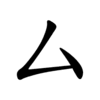厶
| ||||||||
| ||||||||
Translingual
| Stroke order | |||
|---|---|---|---|
 | |||
Han character
厶 (Kangxi radical 28, 厶+0, 2 strokes, cangjie input 女戈 (VI) or X女戈 (XVI), four-corner 20730, composition ⿰𠃋丶)
- Kangxi radical #28, ⼛.
Descendants
Derived characters
Usage notes
Similar strokes occur in various Chinese characters, where they often represent a stylized tail, as in 离 (“beast”) and 鬼 (“demon”).
References
- KangXi: page 163, character 20
- Dai Kanwa Jiten: character 3057
- Dae Jaweon: page 371, character 25
- Hanyu Da Zidian (first edition): volume 1, page 383, character 9
- Unihan data for U+53B6
Chinese
Glyph origin 1
| Historical forms of the character 厶 | |||
|---|---|---|---|
| Warring States | Shuowen Jiezi (compiled in Han) | Liushutong (compiled in Ming) | |
| Bronze inscriptions | Chu slip and silk script | Small seal script | Transcribed ancient scripts |
 |
 |
 |
 |
Ideogram (指事) – revolving around oneself – original character for 私 (“selfish; private”).
According to Han Feizi, which was referenced in Shuowen:
- 古者蒼頡之作書也,自環者謂之厶 [MSC, trad.]
- Gǔzhě Cāngjié zhī zuò shū yě, zì huán zhě wèi zhī sī [Pinyin]
- In olden times, when Cangjie invented the system of writing, a self-encircling element was designated as the character for “private”.
古者苍颉之作书也,自环者谓之厶 [MSC, simp.]
Compare 公 (“public”).
Definitions
| For pronunciation and definitions of 厶 – see 私 (“self; personal; private; selfish; etc.”). (This character, 厶, is the second-round simplified and ancient form of 私.) |
Notes:
|
Japanese
Korean
Vietnamese
Han character
厶: Hán Nôm readings: khư
- This term needs a translation to English. Please help out and add a translation, then remove the text
{{rfdef}}.
References
This article is issued from Wiktionary. The text is licensed under Creative Commons - Attribution - Sharealike. Additional terms may apply for the media files.